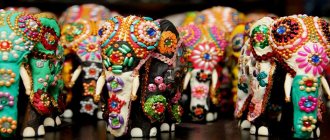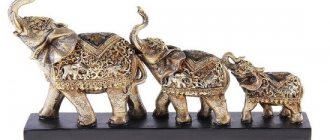The importance of mountains and their advantage over plains is inherent in the very concept of Feng Shui, according to which positive Qi energy is responsible for any positive changes, and Sha energy is responsible for decline and stagnation. Where there are mountains and any elevations, air turbulence will certainly be created, which will prevent the energy from stagnating - and this is very good. In nature, the most favorable areas are those where mountains and water are combined.
Only where there are hills and hills is the prosperity of the family, its well-being, a quiet life and success possible - this is what the Chinese sages believed.
History of mountain landscapes
Already at the beginning of the 1st century AD, artists began to paint rocks and mountain settlements. Mountain landscapes were very common in China, and this style of calligraphy is still characteristic of Chinese artists.
Mountains in the role of the “protagonist” first appeared in the painting of the Swiss portrait painter Konrad Witz. The artist, who worked in the first half of the fifteenth century, devoted his creative life to portraiture, and is considered one of the founders of the art of the Northern Renaissance, but at the same time proved himself to be an outstanding master of the Alpine landscape. He was inspired by the views from the window of his own workshop, which overlooked the Alps, wrapped in a snow coat.
In Europe, too, few artists have not touched upon the image of a mountain landscape in their works. The slopes of the Alps can be seen in the works:
- Vincent Van Gogh;
- Caspar Friedrich;
- in paintings by Italian and German artists.
In Russian painting, the mountains most often painted were Isaac Levitan and Arkhip Kuindzhi. The great poet Mikhail Yuryevich Lermontov also sang the beauty of the mountains. And not only in his literary works, but also in the talented landscapes of the Caucasus Mountains.
Determining the location of the zone in the room
A compass will help determine the location of the sector that is responsible for achievements in work. The northern part of the room, ruled by the element of Water, accumulates energy that affects career advancement. If a person holds a leadership position, then he should properly design the space inside the office. If an employee wants to achieve success in his career, then he needs to properly activate the energy at home.
It will be better if the career area in the living space coincides with the office or library. In cases where space is limited, you can create a professional development corner in the north end of your living or dining room. If the apartment is one-room, then the place of achievement can be part of the hallway or kitchen.
The meaning of paintings depicting mountains
The mountain is a symbol of yin energy. In a mountain feng shui image, the presence of water (yang energy) is desirable so that the combination of these factors can balance the interior of the house and its surroundings. Mountains, according to Feng Shui, signify determination, constant improvement, strength and perseverance in the face of difficulties and obstacles.
The image of mountains does not allow negative energy to linger in the house. It helps qi flow in the right direction, promotes positive changes in life, increases the happiness level of family members, and even helps them recover quickly when they are sick. It is also believed that these landscapes have a beneficial effect on future offspring.
The positive energy of the mountains will be appropriate in every corner of the house, so there are no wishes about where it is best to hang it. For example:
- In your office, images of mountains will help you climb the career ladder, make smarter decisions and act more decisively. A painting helps traders stay calm while doing business, scientists find the right words to prove that they are right, artists are inspired by the little things around them, and so on.
- In the living room, such a landscape gives family members a sense of security and helps get rid of depression.
- In a student’s room, a painting will help to focus on doing homework, become more independent and collected.
From the point of view of Feng Shui, the correct choice of picture is important - the mountains should be attractive, beautiful, with snow-white or green tops, picturesque and inspiring. The image of a lifeless hill will not benefit the energy of the room, and will not give any aesthetic pleasure.
The influence of the painting on our lives from the point of view of Feng Shui
At all times, the paintings were very popular and conveyed good and evil, peace and aggression, calm and chaos. Therefore, it is so important to wisely choose a painting that will decorate your home or office. For example, Feng Shui paintings with a waterfall and a mountain mean prosperity and protection.
According to the science of Feng Shui, the importance of paintings cannot be underestimated, because the images on them can not only evoke various emotions, but also attract spiritual and material benefits into the lives of their owners.
And vice versa. According to Feng Shui, all paintings, canvases and landscapes should evoke only positive emotions in their owners.
If the painting was given to you, it also matters who exactly and with what thoughts made this gift. From the science of Feng Shui it clearly follows that a loved one who wishes you well will give you a picture that carries only bright, positive, warm feelings and perceptions.
A calm range of colors will create a feeling of peace and harmony with the surrounding space, and the image of nature will bring additional positive energy to your home.
Let's look at paintings with a waterfall, sunset, and also with images of mountains, and reveal their meaning according to Feng Shui. All of them represent goodness and will be very useful in almost any home.
Palette of mountain landscapes
The artist puts a special meaning into the colors and shapes of natural objects, thereby conveying to people his view of the world. If the shape of a mountain is often depicted as a triangle, then the color solutions are varied. Typically the color palette includes:
- black;
- grey;
- white;
- blue;
- green.
By using light colors, the outlines of objects are emphasized, and valleys and objects added to enliven the landscape are highlighted with dark or bright shades.
Paintings depicting mountains always fascinate and attract the eye. You can have different attitudes to the hidden meanings of certain images, but the fact that a mountain landscape can fit into any interior and decorate it is for sure.
Source : Satom marketplace materials.
Tags:
- Alps
- mountainous landforms
- mountains
- scenery
- Feng Shui
Five types of mountains in Feng Shui
Five types of mountains in Feng Shui
When looking at the hills and mountains that border your property or surrounding your city, it is always useful to understand what meanings are associated with their shape in Feng Shui. For the Chinese, life surrounded by mountains is always considered desirable, as there is a belief that areas with mountainous terrain are the natural habitat of auspicious earthly dragons.
Hills and mountains can be divided into five varieties depending on their shape, which corresponds to the nature of each of the five elements: water, fire, metal, wood and earth. This classification is carried out as a result of analyzing the side profile of the mountain at the horizon level, taking into account the shape of its peak and the steepness of the slopes. The shape of the mountain determines how convenient this place is to live.
A feng shui beginner will likely have difficulty identifying different types of mountains and hills, but don't worry about it. Once you remember the basic differences, you will practically develop the ability to see the world through the eyes of Feng Shui. However, keep in mind that often mountains of different shapes are adjacent to each other and such proximity introduces certain difficulties in interpretation and may require the presence of an experienced Feng Shui master. First of all, you should remember that wavy, gentle slopes are always favorable, while slopes with sharp edges are unfavorable. Ribbed slopes create “poison arrows”. If the sharp edge of a nearby mountain is pointed at your home or building, it is very bad for you.
From the point of view of Feng Shui, the three types of mountains that are classified as auspicious correspond to wood, earth and metal. Pointed mountains belong to the water element and are considered too yin, while cone-shaped mountains belong to the fire element and are considered too yang. Both types of mountains are classified as inauspicious unless your birth date is in harmony with the fire and water elements.
| Mountains corresponding to the element of water. |
| Mountains corresponding to the earth element are square in shape. They look like a plateau with a flat, extended top. The planet Saturn is associated with such a mountain. People born in the year of metal are especially recommended to live near mountains of this characteristic shape. |
| Mountains corresponding to the element of fire. |
| Mountains corresponding to the metal element are extremely favorable. They are usually smoothly rounded and elongated. Such mountains have a wide base, so they look like hilly hills. This type of mountain brings to mind gold and is considered extremely auspicious. |
| Mountains whose shape corresponds to the element of wood are usually round and tall. This type of mountain is associated with the planet Jupiter. The wood element is also associated with growth. People born in the year of fire will greatly benefit if they settle near this type of mountain. In addition, such mountains could potentially be inhabited by dragons and are therefore favorable for life. |
Terrain levels
The level of the terrain on the left side of your house should be higher than on the right side. The dragon (left) must dominate the tiger (right) for favorable Feng Shui to be established. If the “tiger” side is higher, a good way to correct this situation is to install a high lantern on the “dragon” side, that is, on the left. Its presence will increase the qi on the “dragon” side, creating the necessary balance. There is another solution - to artificially change the topography of the earth's surface by placing a small mound on the left side of the house, if possible.
If you live in a city, this rule can be illustrated by the presence of a slightly taller building compared to your house, which stands on the left side. However, make sure that it does not overhang your home. If the buildings are located too close to your home, it is unfavorable.
If your house is located in the center, then the building to your left represents the green dragon. If it's a little taller than your home, that's a good sign. At the same time, if the building to the right of your house is slightly lower than the building located to the left, the symbol of a beautiful white tiger is born, and your house will acquire auspicious classical Feng Shui. If at the same time the building of your house does not look like a dwarf against the background of each of the buildings next to it, its Feng Shui is not negatively influenced by them.
| If the terrain level on the right side of your house (tiger side) is higher than on the dragon side, install a tall, bright lantern on the dragon side. By doing this, you will raise her energy and restore energy balance. |
| The high-rise building to the left of the building in question symbolizes the green dragon, and the high-rise building to the right of it symbolizes the white tiger. The green dragon must be taller than the white tiger. |
Water on the mountain
“Water on the mountain” is one of the four main taboos of Feng Shui. When the water reaches the edge, it spills and causes great trouble. Therefore, never lay the roofs of houses with blue tiles. Blue is the color of the water element, and this alone can be enough to cause you to suffer severe financial losses from time to time.
Hillside House
You need to know which part of the hill is most favorable. In Hong Kong, representatives of the local business community, or rather the richest among them, live on the hilly slopes of the island. Knowledgeable people do not settle at the foot or at the very top or peak of a hill. Instead, the Chinese prefer to live in apartments and houses located at mid-hill level. They know that the most favorable part of the hill is near its middle, from where they can simultaneously enjoy the sea view and the protection of the high peak behind them. The least suitable area for habitation of a hill is located at its top, especially if the fog spreads below this area. According to Feng Shui principles, living on a hilltop puts you at the mercy of the wild winds. There is no protection or support.
The same reasoning applies to living in penthouses of high-rise buildings. It's great if you live on the top floor when your apartment building isn't the tallest in the area, but I wouldn't recommend living on top of the tallest skyscraper surrounded by a mass of similarly tall buildings. The danger of being at the very top is greatly aggravated if there is water there. Penthouses or rooftop decks with large swimming pools are especially vulnerable.
More material on this topic
Environmental factors conducive to financial success For wealth, you need to make room Choosing a plot of land in Feng Shui View from the threshold of an apartment Feng Shui decoration and decorations What effect does the color yellow have on a child according to Feng Shui
Feng Shui. Basics of harmonious nutrition
Author: Brown S., Saunders S.
Year of publication: 2005
Format: 27.5x22x1.5
← all articles











